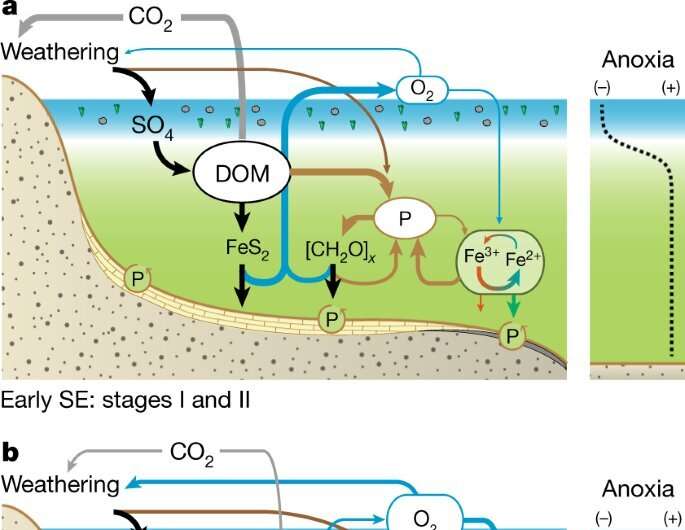This article has been reviewed according to Science X's editorial process and policies. Editors have highlighted the following attributes while ensuring the content's credibility:
fact-checked
peer-reviewed publication
trusted source
proofread
New theory may explain Earth's oxygen-rich atmosphere and the late evolution of animal life

A new study may have found a missing link that helps explain the Earth's unique oxygen-rich atmosphere—and the evolution of animal life on the planet.
The findings in the paper "Uncovering the Ediacaran phosphorus cycle," led by a Forrest Research Foundation Fellow from The University of Western Australia and published today in Nature, could solve the mystery of why oxygen levels remained too low for animals to breathe for 90 percent of Earth's history.
The first major evolutionary event of animal life occurred during an event dubbed the Shuram Excursion—between 570 and 550 million years ago—which is believed to represent a massive release of carbon dioxide and oxygen into the atmosphere and oceans as a result of increasing ocean phosphorus levels.
To test the theory, researchers used a newly developed tool to track the abundance of phosphorus in the oceans hundreds of millions of years ago, recorded in six locations in Australia, China, Mexico and the US.
The data and Earth chemistry model revealed increasing ocean phosphorus levels could not have explained the rise of oxygen. The effect was only replicated by the model when large quantities of sulfate rock were weathered, releasing sulfate into the oceans to produce vast amounts of oxygen.
Lead author and Forrest Fellow Dr. Matthew Dodd, from the UWA School of Earth Sciences, said the results suggested sulfate, rather than phosphorus, was the main control in the oxygenation of the planet during the first major evolution of complex life.
"Our findings may explain the prolonged low levels of oxygen throughout Earth's history and consequently the late evolution of animal life on Earth," Dr. Dodd said.
"Importantly, we observe that ocean phosphorus was predominantly low when oxygen levels were low throughout the Shuram Excursion.
This phenomenon would have locked the early oceans and atmosphere into an oxygen devoid state."
Data from the study also holds implications about the possibility of intelligent life on other planets.
"These results suggest other potentially habitable planets may support complex intelligent life, only if provided with long enough incubation times," Dr. Dodd said.
"This could imply planets around stars larger than the sun may not develop complex intelligent life due to the relatively short lifetime of large stars."
More information: Matthew S. Dodd et al, Uncovering the Ediacaran phosphorus cycle, Nature (2023). DOI: 10.1038/s41586-023-06077-6
Journal information: Nature
Provided by University of Western Australia




















